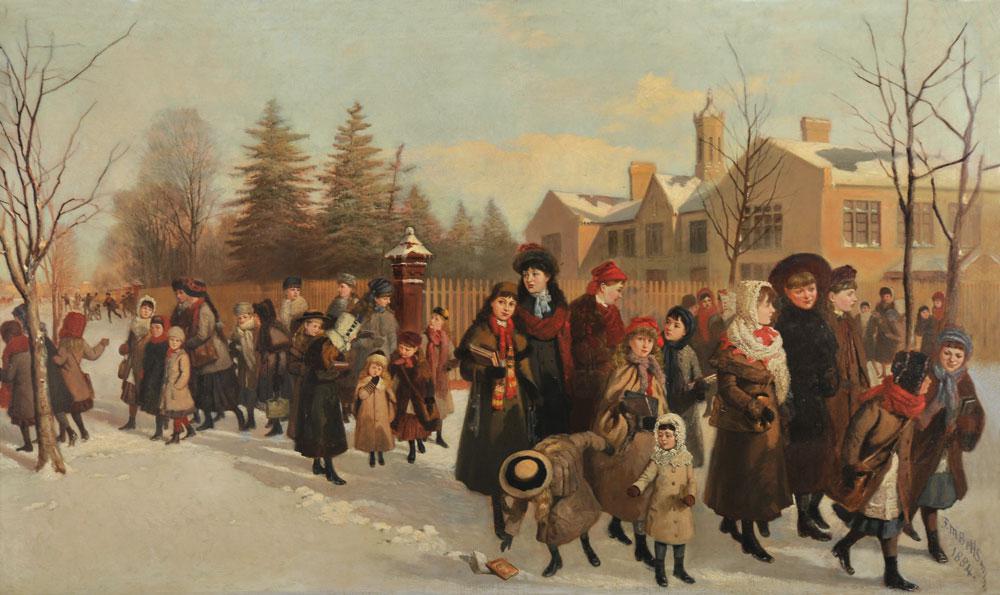Frederic Marlett Bell-Smith (1846–1923) was born in London, England. His father was a painter of miniature portraits, and young Frederic studied painting with him. The family immigrated to Canada and settled in Montreal during the Confederation summer of 1867. Bell-Smith was employed by the prominent photographer James Inglis, and in 1871 he moved with his wife to Hamilton, Ontario, where he worked at a branch of the Inglis photography firm. Three years later, the couple moved to Toronto, where Bell-Smith continued work in photography and taught a year at the Ontario School of Art.
When Bell-Smith returned to Hamilton in 1879, he had been exhibiting his work for about a decade: watercolours, mainly, but also tinted photographs and, increasingly after 1877, oil paintings. In 1881 he moved to London, Ontario, to become director of fine arts at Alma College in nearby St. Thomas. Around this time he also made a trip to Paris and studied briefly at the Académie Colarossi, returning with a serious commitment to oil painting. Back in London, he became drawing master to the Central Public Schools. In 1887 he took advantage of the free passes then being offered to artists on the new Canadian Pacific Railway route through the Rocky Mountains. It was a turning point. He was appointed principal of the Western branch of the Toronto Art School, and lived in Toronto until the end of his life, frequently visiting the Rockies and the West Coast. The magnificent landscape paintings that resulted from these journeys are the works that have become the hallmarks of his reputation.
Despite the rising arc of Bell-Smith’s career trajectory, one canvas from before his Western trips is arguably his masterpiece. Exhibited with the Ontario Society of Artists in Toronto in 1884, and then again that year in the Royal Canadian Academy exhibition in Montreal, it is a large canvas first called Daughters of Canada, and now known as The Return from School (1884). The painting depicts the girls of Union Grammar School on King Street at Colbourne in London (now the site of Alexandra Public School) leaving the grounds at the end of the school day by the girls’ exit (classes were then segregated by gender). A work that clearly engaged Bell-Smith deeply, it draws on the full range of his artistic experience to that point. Every face is highly finished and strikingly individual. The ease, yet precision, with which the figures are arranged in a highly naturalistic but also dynamic composition speaks to his years of experience in the photography business, where composite images were created in the studio from individually shot figures. And, of course, in the overall rhythmic flow of tone and hue, the sensitive articulation of each figure, and the masterful level of finish to it all, we can recognize the consequence of his recent academic instruction in Paris.
More than just a demonstration of skill, the painting is a celebration of the role of women in Canadian society. These girls were his students, and he clearly enlisted their support in order to capture their individuality. As individuals, however, they are united by their evident care for one another, the older ones escorting the younger with considerate attention, with the affection that so clearly flows from shared values. There is a hierarchy evident, but it is a hierarchy based on mutual respect and the understanding that what is received will at some point be given. All of this is embraced within the supportive light of a bright southwestern Ontario winter day, reinforced by the girls’ comfortable and attractive seasonal clothing. What could be more encouraging, more affirming of a bright future for society, especially when we espy down the street to the left the boys bursting from their gate like shrapnel from a cannon?
This is an article from the Spring 2013 issue of Canadian Art. To read more from this issue, please visit its table of contents.

 Frederic Marlett Bell-Smith The Return from School 1884 Oil on canvas 91 cm x 1.52 m Courtesy Museum London / photo John Tamblyn
Frederic Marlett Bell-Smith The Return from School 1884 Oil on canvas 91 cm x 1.52 m Courtesy Museum London / photo John Tamblyn







